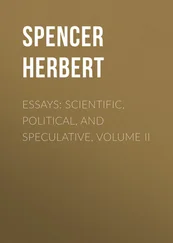The general nature of Laplace's theory scarcely needs stating. Books of popular astronomy have familiarized most readers with his conceptions;—namely, that the matter now condensed into the Solar System, once formed a vast rotating spheroid of extreme rarity extending beyond the orbit of the outermost planet; that as this spheroid contracted, its rate of rotation necessarily increased; that by augmenting centrifugal force its equatorial zone was from time to time prevented from following any further the concentrating mass, and so remained behind as a revolving ring; that each of the revolving rings thus periodically detached, eventually became ruptured at its weakest point, and, contracting on itself, gradually aggregated into a rotating mass; that this, like the parent mass, increased in rapidity of rotation as it decreased in size, and, where the centrifugal force was sufficient, similarly left behind rings, which finally collapsed into rotating spheroids; and that thus, out of these primary and secondary rings, there arose planets and their satellites, while from the central mass there resulted the Sun. Moreover, it is tolerably well known that this a priori reasoning harmonizes with the results of experiment. Dr. Plateau has shown that when a mass of fluid is, as far may be, protected from the action of external forces, it will, if made to rotate with adequate velocity, form detached rings; and that these rings will break up into spheroids which turn on their axes in the same direction with the central mass. Thus, given the original nebula, which, acquiring a vortical motion in the way indicated, has at length concentrated into a vast spheroid of aeriform matter moving round its axis—given this, and mechanical principles explain the rest. The genesis of a Solar System displaying movements like those observed, may be predicted; and the reasoning on which the prediction is based is countenanced by experiment. [17]
But now let us inquire whether, besides these most conspicuous structural and dynamic peculiarities of the Solar System, sundry minor ones are not similarly explicable.
Take first the relation between the planes of the planetary orbits and the plane of the Sun's equator. If, when the nebulous spheroid extended beyond the orbit of Neptune, all parts of it had been revolving exactly in the same plane, or rather in parallel planes—if all its parts had had one axis; then the planes of the successive rings would have been coincident with each other and with that of the Sun's rotation. But it needs only to go back to the earlier stages of concentration, to see that there could exist no such complete uniformity of motion. The flocculi, already described as precipitated from an irregular and widely-diffused nebula, and as starting from all points to their common centre of gravity, must move not in one plane but in innumerable planes, cutting each other at all angles. The gradual establishment of a vortical motion such as we at present see indicated in the spiral nebulæ, is the gradual approach towards motion in one plane. But this plane can but slowly become decided. Flocculi not moving in this plane, but entering into the aggregation at various inclinations, will tend to perform their revolutions round its centre in their own planes; and only in course of time will their motions be partly destroyed by conflicting ones, and partly resolved into the general motion. Especially will the outermost portions of the rotating mass retain for a long time their more or less independent directions. Hence the probabilities are, that the planes of the rings first detached will differ considerably from the average plane of the mass; while the planes of those detached latest will differ from it less.
Here, again, inference to a considerable extent agrees with observation. Though the progression is irregular, yet, on the average, the inclinations decrease on approaching the Sun; and this is all we can expect. For as the portions of the nebulous spheroid must have arrived with miscellaneous inclinations, its strata must have had planes of rotation diverging from the average plane in degrees not always proportionate to their distances from the centre.
Consider next the movements of the planets on their axes. Laplace alleged as one among other evidences of a common genetic cause, that the planets rotate in a direction the same as that in which they go round the Sun, and on axes approximately perpendicular to their orbits. Since he wrote, an exception to this general rule has been discovered in the case of Uranus, and another still more recently in the case of Neptune—judging, at least, from the motions of their respective satellites. This anomaly has been thought to throw considerable doubt on his speculation; and at first sight it does so. But a little reflection shows that the anomaly is not inexplicable, and that Laplace simply went too far in putting down as a certain result of nebular genesis, what is, in some instances, only a probable result. The cause he pointed out as determining the direction of rotation, is the greater absolute velocity of the outer part of the detached ring. But there are conditions under which this difference of velocity may be too insignificant, even if it exists. If a mass of nebulous matter approaching spirally to the central spheroid, and eventually joining it tangentially, is made up of parts having the same absolute velocities; then, after joining the equatorial periphery of the spheroid and being made to rotate with it, the angular velocity of its outer parts will be smaller than the angular velocity of its inner parts. Hence, if, when the angular velocities of the outer and inner parts of a detached ring are the same, there results a tendency to rotation in the same direction with the orbital motion, it may be inferred that when the outer parts of the ring have a smaller angular velocity than the inner parts, a tendency to retrograde rotation will be the consequence.
Again, the sectional form of the ring is a circumstance of moment; and this form must have differed more or less in every case. To make this clear, some illustration will be necessary. Suppose we take an orange, and, assuming the marks of the stalk and the calyx to represent the poles, cut off round the line of the equator a strip of peel. This strip of peel, if placed on the table with its ends meeting, will make a ring shaped like the hoop of a barrel—a ring of which the thickness in the line of its diameter is very small, but of which the width in a direction perpendicular to its diameter is considerable. Suppose, now, that in place of an orange, which is a spheroid of very slight oblateness, we take a spheroid of very great oblateness, shaped somewhat like a lens of small convexity. If from the edge or equator of this lens-shaped spheroid, a ring of moderate size were cut off, it would be unlike the previous ring in this respect, that its greatest thickness would be in the line of its diameter, and not in a line at right angles to its diameter: it would be a ring shaped somewhat like a quoit, only far more slender. That is to say, according to the oblateness of a rotating spheroid, the detached ring may be either a hoop-shaped ring or a quoit-shaped ring.
One further implication must be noted. In a much-flattened or lens-shaped spheroid, the form of the ring will vary with its bulk. A very slender ring, taking off just the equatorial surface, will be hoop-shaped; while a tolerably massive ring, trenching appreciably on the diameter of the spheroid, will be quoit-shaped. Thus, then, according to the oblateness of the spheroid and the bulkiness of the detached ring, will the greatest thickness of that ring be in the direction of its plane, or in a direction perpendicular to its plane. But this circumstance must greatly affect the rotation of the resulting planet. In a decidedly hoop-shaped nebulous ring, the differences of velocity between the inner and outer surfaces will be small; and such a ring, aggregating into a mass of which the greatest diameter is at right angles to the plane of the orbit, will almost certainly give to this mass a predominant tendency to rotate in a direction at right angles to the plane of the orbit. Where the ring is but little hoop-shaped, and the difference between the inner and outer velocities greater, as it must be, the opposing tendencies—one to produce rotation in the plane of the orbit, and the other, rotation perpendicular to it—will both be influential; and an intermediate plane of rotation will be taken up. While, if the nebulous ring is decidedly quoit-shaped, and therefore aggregates into a mass whose greatest dimension lies in the plane of the orbit, both tendencies will conspire to produce rotation in that plane.
Читать дальше












